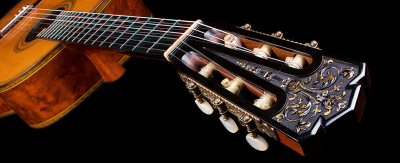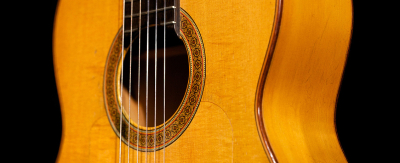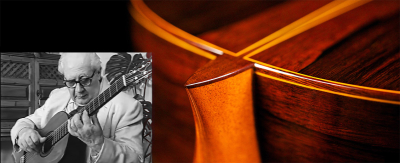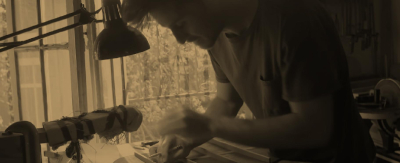The Torres Sound
excerpted from Antonio de Torres: Guitar Maker and His Life & Work by Jose L. Romanillos
Julian Arcas, undoubtedly the most influential Spanish guitarist of the second half of the nineteenth century, was one of the first leading players in Spain to take cognizance of Antonio de Torres as a guitar maker, and his influence was a determining factor in Torres’ development. Arcas also played a great role in establishing Barcelona as the center for guitar playing in Spain. He was grounded in the classical tradition established by Aguado and taught by his father. In 1853, when he was twenty years old, he gave a recital in Madrid in the salon of the Postas Peninsulares which helped to establish his reputation as a fine guitarist of that time.
According to the account given to Fritz Buck by Nicolas Jimenez, Arcas borrowed the famous Leona guitar for one year (see Chapter 14). He was a guitarist / composer whose music did not reach the heights of other composers such as Sor or Aguado and although criticized by Segovia for playing “elemental kind of music”1, he was a rare phenomenon who was able to popularize la guitarra fina, bridging the gap between the popular guitar and the concert instrument. He also created a new, however slight, repertoire for the guitar and he might have been, as Segovia says, “a spontaneous artist, not a cultivated one” but his influence was widely felt, particularly in the years between 1860 and his retirement of 1872, for he brought a new approach to guitar playing to the fore and introduced to a wider audience the new concept of guitar making as developed by Antonio Torres. His virtuosity found a wider range of expression on the Torres guitar and with it he was able to introduce into guitar playing a new range of sonorities, effects and dynamics. To criticize Arcas for playing a type of elemental music is to miss his real contribution to the world of guitar. What really mattered at the time was not the quality of the music that he chose to play but the manner in which he played, the intrinsic quality of the sound, and the variety that he produced with the innovatory guitar.
It is not necessary to specify [that] what Senor Arcas played at his concert-Orpheus didn’t bind himself down to minims and semibreves, and St. Cicilla [sic] probably couldn’t tell a clef from a diapason-suffice it that he “discoursed most excellent music,” and that his audience were perfectly charmed, including the Duchess of Cambridge and the Princess Mary. – Brighton Observer 21 November 1862
The guitar in nineteenth century Spain did not have to compete with other philharmonic instruments for the audience did not demand any more than what the guitar could produce, oblivious of the unseemly lack of volume of the guitar as compared with other instruments. Torres’ guitar in the hands of Arcas and later in the hands of Tarrega, Pujol, Cuervas, Manjon, and others, apported a new dimension that was intrinsically Spanish and with the emphasis on the sensual and romantic character of the sound, rather than in its complex musical structure.
The Torres guitar, lighter in weight, responded nobly to the virtuoso approach of Arcas, who combined arrangements of operatic themes with nationalistic airs such as rondenas, jotas, muneiras and boleros greatly admired by audiences in Spain and abroad. The reviewer of the Brighton Gazette, 20, November 1862 wrote: “but perhaps the most entertaining piece of the whole was ‘La Gallegada,’ a Spanish national air by the performer himself. It is impossible to describe the charming and entertaining varieties which characterized his performance of this air. It seemed to bring out all his resources as a musician and a manipulator upon the guitar. He was rapturously encored.”
The tonal quality of his Torres guitar did not pass unnoticed by the audiences and music reviewers. Comparisons with other virtuosi such as Huerta and Regondi put Arcas’ virtuosity into context.
The guitar, in his hands, is a speaking instrument, aye and a crying instrument too, for the tremulous tones he produces, with such speaking-like quality, are so supplicatory, that one might almost fancy his instrument was appealing to him for mercy.-Brighton Gazette, 30 October 1862.
According to the same reviewer Senor Arcas had refined taste, but with a clearness, rapidity, and a precision that would seem impossible to accomplish upon such an instrument. The Brighton Observer, 21 November 1862, went as far to suggest that: “the very deuce himself has got into the guitar and is striving vainly to escape through the soundholes [sic].”
Time and time again reviewers remarked on the range of sonorities and effects that he was able to cajole from his guitar. In 1862, when Arcas was on his way to England, carrying with him his Torres guitar, he gave a concert in the Madrid Conservatory that was extremely well received by the music critic of La Discusion, 1 July 1862, who remarked about the characteristic, beautiful and expressive performance: “the simplicity and purity of the cantos… fullness and roundness of its tone produced a marvelous effect.”
The guitar was not only resonant in the bass register but had clarity to contrast with the deep melodious bass resonances of the guitar.
Sometimes the instrument was sonorous almost to resonance; then it had the deep constraint of a contra-basso; again it would emit notes of harmony pellucid in their clearness.-Brighton Guardian, 29 October 1862.
It was, according to Pujol, in 1862, at a concert given by Arcas in Castellon, where Francisco Tarrega first felt the impact of Arcas’ artistry. Arcas was playing on La Leona and Tarrega was impressed by the “warm sound of that guitar contracted especially for Arcas by Antonio de Torres who wanted to call it La Leona because he considered it the best of all his existing guitars. ” This impression that Tarrega “never forgot” resulted in the acquisition of his first Torres guitar in 1869, FE 17, which he played for nearly a quarter of a century. Emilio Pujol, pupil and admirer of Tarrega, and owner of two Torres guitars, considered Tarrega’s first Torres as the very bast guitar he had played. Pujol quotes from the review made for a Paris newspaper saying, “with a much more difficult instrument I listened to last night the sweetest harmonies, the most celestial sounds ever produced by an instrument.”
By 1876, Torres was making eleven-string guitars, three of which are extant, and the spell of the one played by Gimenez Manjon, a blind musician, cast on Miguel Llobet in 1889 during a recital that he gave in Barcelona, changed Llobet’s life and guided him towards a musical career and converted him into an ardent admirer of the Torres guitar. The anonymous reviewer of Manjon, writing in Diario de Avisos (Zaragoza), emotively describes the concert given with his eleven-string guitar and how “each string carries the voices and modulations of a thousand angles; his guitar is the temple of emotions, the arcanum of abundance that move and delights the heart escaping in sighs from those threads that seem guardians of mermaids’ songs.” Emotive sentiments indeed but it is certain that to experience the warm spontaneity and balance of a Torres guitar in concert left an indelible impression, and just as Tarrega was excited by Arcas’ Torres guitar, Llobet by that of Manjon, those who attended the recital given by Llobet were not only spellbound by the sheer musicianship of the artist but by the musical quality of the guitar. The Irish writer, Mrs. Villiers-Wardell, had the opportunity of listening to Llobet during one of his concerts in Paris and describes the enlightening event.
Miguel Llobet is a notable guitarist. He is a favorite pupil of Tarrega-the greatest master of the guitar Spain has known during the past fifty years-and like his illustrious maestro, he is able to make the guitar speak. It was in Paris that I first had the pleasure of making this musician’s acquaintance, and I confess to a feeling of intense surprise when I heard him softly playing the opening notes of one of Chopin’s most exquisite Nocturnes. I had never thought of associating the guitar with serious music, but in the hands of Miguel Llobet is gave us Bach and Mendelssohn, Chopin and Beethoven. This sounds incredible, but then the guitar is an instrument capable of wonderful things-in thoroughly skilled hands. Towards the end of the evening we pressed the artist to give us something “really Spanish” and he played-in memorable style-la ‘Jota’, composed by Tarrega himself.
Fortunately some of the early recordings made by Llobet with a Torres guitar have survived to give a glimpse of his musicianship and also of the sound of a Torres guitar made in 1859. Many stories are still told about the lure that Torres’ guitars had for enthusiasts who heard them being played. Ramon Capel, “el Viejo,”recounted to me a story that he witnessed some years ago in the village of Laujar. An Indiano (a rich emigrant returned from America), on hearing a Torres guitar being played, could not resist the temptation of possessing a marvelous guitar that he subsequently bought for a very high price, against the fierce resistance of the owner who was reluctant to be parted from it but succumbed to a very inflated price.
The story of La Leona is equally emotive and reflects the emotions that the owners felt when parting with this Torres guitars. The anecdote related by Llobet’s daughter illustrates the obsession of some enthusiasts in their striving to equal the great virtuoso guitarists. During on of Llobet’s visits to France he made the acquaintance of a Franco-Argentine doctor named Ramauge. A man passionately fond of the guitar, he became a good friend of Llobet whom he accompanied everywhere and whom he invited on several occasions to stay in his family home in Palma de Mallorca. Enamored of the sound that Llobet produced on his Torres guitar, Ramauge longed to acquire a Torres himself, the only instrument that could satisfy his desire to emulate Llobet. Llobet possessed several Torres guitars and was constantly importuned by the doctor to sell him one. Time and again Llobet refused, until, worn down by Ramauge’s persistence, he finally consented to sell him one. Delighted with his new aquisistion, the doctor strove hard to obtain the same sweet sounds that he had been accustomed to hear from Llobet but to no avail. The will was there but he lacked the technique and artistry to coax from the guitar the sound he so much enthused over. One day, tired at the abuse dealt out by the doctor, the bridge suddenly flew off, breaking the hapless doctor’s wrist. The doctor often recounted this story, saying that the incident was a divine retribution. He had been punished; firstly for having greatly inconvenienced Llobet with his persistent requests, and secondly, for his profane treatment of Torres’ guitar.
Similar enthusiasm seized Jose Rojo y Cid, a native of Toledo and the owner of three Torres guitars, one with eleven strings (SE 71). This instrument gave him unbounded pleasure and such was his obsession for playing his Torres guitar that he had a special small table made to serve him as both music stand and dining table so that in between mouthfuls of food he could continue playing In his beautiful estate in nerja, encircled by orange trees and iron railings, the local gypsies would come together to listen to the sound of his much loved Torres. Upon hearing the first notes the gypsies gathered round expectantly by the wrought-iron gate that stood at the entrance of the estate. Silently pressed against the railings they became transported by the beauty of the sound. According to Jose Rojo y Cid’s son-in-law, some were so moved by the drifting melodies that they unthinkingly bit the iron bars of the gate seeking relief to their overflowing emotions.
There was something special about the Torres sound that won the hearts of learned musicians and laborers alike; even those inexpensive guitars that Torres made for neighbors, friends, and family with their clear, distinctive, and appealing sound took on legendary proportions. On quiet evenings in La Canada, while waiting for the glue to dry or weary after a long day’s work, Torres would relax by playing his own compositions and popular airs to the delight of his eavesdropping neighbors. This routine was well known among neighbors and farm workers toiling in the nearby fields behind Torres’ house and it was a common occurrence to see the laborers halting their work during the maize harvest so that the cracking noise made by the peeling of the dried leaves of the cobs should not drown the sound of the guitar.
It was precisely this sound that had conquered such a wide public. Juan Riera wrote in his biography of Emilio Pujol that such was the enthusiasm Matilde Curvas stirred among the audience when playing her Torres (FE 11) that the listeners could not believe that a framework of wood and glue could produce such marvelous resonances and sounds. On one occasion the incredulous listeners snatched the instrument from the artist’s hands to make sure that it did not have built into it a “device that produced special sounds.”
Victoria Kingsley mentions the “singing tone” of Torres’ guitars, which she heard when Pujol and his first wife, Matilde Cuervas played their Torres guitars.
He (Pujol) taught all pupils in their first lesson never to touch another person’s instrument without asking their permission. This rule was even observed between him and Mathilde [sic]. By the way, not interested in the larger, heavier guitars becoming fashionable, they had each a Torres, and I can assure you that this make could make a singing tone that carried well from one room to another as was proved with tests.
Today Torres’ name still lives on in Nijar, and is treated with equally high respect, and guitars, be they good or bad, with a label or without, are said to be Torres’. Until very recently it was still possible to hear one of these guitars being played by Antonio Segura, a native of Nijar who, as a young man, had acquired a Torres guitar. This rugged laborer, who was also the village bonesetter, always finished the day by playing his beloved cypress guitar, a ritual that was never broken. According to his family, the guitar was hung above the bed next to the traditional crucifix. His custom was to sit down alone in a small room in the corner of the farmhouse and play to himself his favorite melodies. If he was interrupted while playing, his face would break into a smile and with pride and satisfaction he would exclaim, “Hasn’t my guitar a wonderful sound!”
Despite Segovia’s adverse comments about the quality of Miguel Llobet’s surviving original recordings (to the effect that they should be destroyed as an act of respect for him and his memory), these existing records not only give an indication as to Llobet’s musicianship and interpretation, they also keep for posterity the sound of Torres’ instruments as played by a leading guitarist of the time. These records represent an historical document and, although they may not possess the quality of sound demanded by Segovia, they still maintain a high musical quality and a freshness of approach that captivates the listener. It is true that some of the pieces, particularly that of the Sarabande from the Partita No. 1 by Bach (El Maestro Records, reissue, side two, band 4) has a shrill sound, but there are other records such as Evocacion and the Catalan Songs that have a fine musical quality.
Although there is no acknowledgement on the records by either player as to the instruments they used for their records, it is known that Llobet used his 1859 Torres and Maria Luisa Anido a 1918 Enrique Garcia guitar. Llobet’s Torres (FE 09) had a tornavoz and there is an indication in the texture of the sound suggesting a certain reverberation of the tornavoz which colors the sound quality. It is well-known though Ricart Matas that Llobet obtained his Torres guitar already damaged from Mr. Sharp, an American millionaire, and that although it was badly cracked Llobet refused to have it mended for fear that the guitar might lose its quality.12 Llobet was in possession of this Torres by 1916. In a photograph taken in 1916 by Lambert Suydam, Jr. of New York, which appears in the booklet accompanying El Maestro Records’ reissue, Llobet is seen holding his favorite Torres. The same guitar can be seen in a photograph he had taken with the young Maria Luisa Anido in Buenos Aires in the 1920s which appears in the programme by Casa Sors in Barcelona for the concert in memory of Miguel Llobet, given by Maria Luisa Anido on 29 April 1977. According to Maria Luisa Anido this was the instrument used by Llobet for all his recordings.
0 comment







